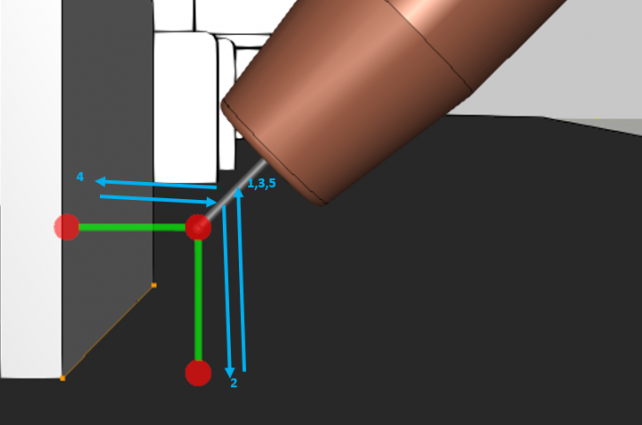Chris Heit, Application Engineering Specialist
In our previous article, Virtual to Reality: Delivering Accuracy to The Real World we discussed some of the factors that can reduce the accuracy of robot programs created offline, and a variety of tools and methods which are commonly used to address inaccuracies. One of those tools was Touch-Sensing. In this article, we will take a deeper dive into exploring how it works, when it can be useful, and what some of its limitations are.
Touch-sensing is used to adjust the weld positions on real parts that fluctuate due to manufacturing imperfections. First, the robot needs a “Master Point” or a “Master Program”; a program where the points are in the ideal location in space. In online robot programming, this “Master Program” is just the original program for the part being welded. In the case of offline robot programming, the simulation program is the master program, and the CAD is considered the master part as it will be the most accurate. When the part is made in the real world it will contain some imperfections due to limitations in the manufacturing process.
It is important to emphasize that the ‘ideal location in space’ is NOT the ‘ideal location on the current part’. It may have been the ideal location on the first part, but if touch-sensing is being used that means that the subsequent parts are not in the exact same location, and so these points will no longer be correct on those parts. The robot will then touch some part of the torch (wire or nozzle) against the part to determine the actual location of the part in space. The difference between this actual location and the location from the Master Program is the correction that needs to be applied to the point(s) of the Master Program. For example: if a point in the Master Program has an X coordinate of 100, and the Touch Point for that Master Point finds the part at an X coordinate of 105, then a correction of 5 in the X-direction needs to be applied to the Master Point.
One of the most common touch-sensing methods is two-point touch sensing, where the robot will touch on the part in two different locations (once on each face, then on either side of the Master Point). This method will correct the Master Point one dimension at a time and is ideal for simple fillet welds. There are several different methods, each with its own advantages and ideal use cases.
The way that the robot registers a touch on the workpiece during touch-sensing is straightforward. For nozzle and wire touch-sensing, a closed circuit will be completed when the nozzle or wire contacts the part. When the robot detects that the circuit has been closed, the current coordinates of the robot are recorded for the correction calculation. A limitation of wire and nozzle touch-sensing is that it typically only works with ferrous metals. Aluminum, for example, is a metal that does not work well with touch-sensing, due to the aluminum oxide which forms at its surface. This oxide interferes with the circuit being closed when the nozzle or wire contacts the part and prevents the robot from determining where the part surface is in space (potentially damaging your torch if you’re not careful). Even large buildups of mill scale on part surfaces can interfere with touch-sensing. There are systems that can work around these limitations, such as touch-sensing systems which use a higher voltage and run at a lower robot speed to improve the ability of the nozzle or wire to make contact and close the circuit through aluminum oxide. Laser touch-sensing is also gaining popularity in robotic welding since it uses the focal point of a laser to measure ‘contact’ with a part’s surface and is not impeded by aluminum oxide or mill scale buildup.
Another downside to touch-sensing is the time and effort needed to program the touch operations. A simple, straight-line weld can have as little as two points; one at the start, and the other at the end. To perform a two-point wire touch-sensing operation on both points of these welds, an additional 10 points will be needed, at least. Five additional points for each weld point. The image below shows the number and location of points needed for a typical two-point wire touch-sense. This represents a significant increase in teach-pendant programming time.
Enter Offline Robot Programming (OLRP). In OCTOPUZ, these points can be generated automatically, based on the weld path you have programmed. Not only is the programming of touch-sensing operations done offline, but the programming time is reduced to almost nothing. This opens the door to touch-sensing in cases where the programming time previously made it a non-starter.
Despite the upfront cost of the additional hardware needed for the robot, and the additional cycle-time it adds to welding operations, touch-sensing is a very effective tool at reducing the inaccuracies of robot welding operations.